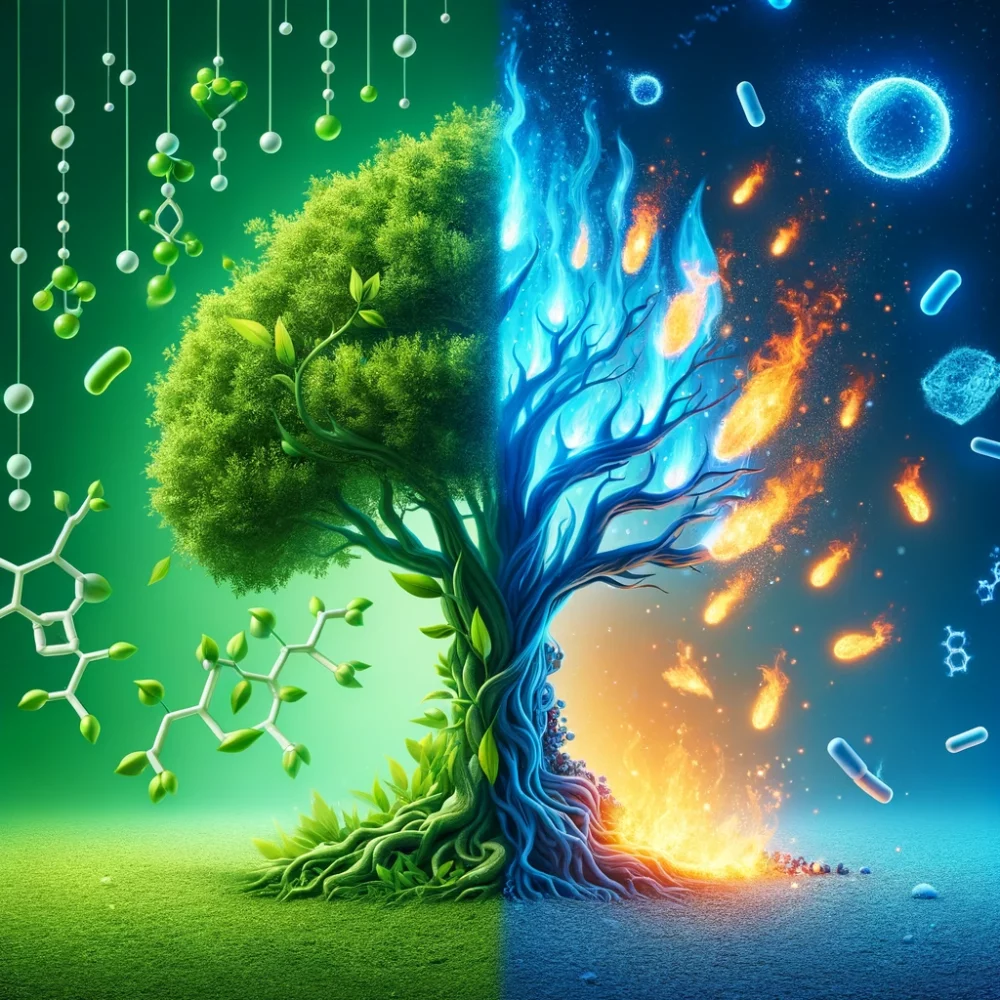The human body is an intricate machine, finely tuned to perform at its best. Central to our body’s operations including the metabolic processes are two processes that seem to be opposites yet are crucial for our overall health and well-being: anabolism and catabolism.
By understanding these metabolic processes, we can align our lifestyle choices to harness their potential and achieve our health goals.
A Quick Intro to Anabolism and Catabolism
At the very heart of our body’s functionality, we find two processes working in tandem.
- Anabolism: Think of anabolism as the body’s ‘construction worker.’ This process involves the creation and building of complex molecules from simpler ones. It’s all about growth, maintenance, and energy storage, which are all parts of the anabolic process. When we consume nutritious food and engage in strength training, we foster an anabolic state, promoting muscle development and recovery.
- Catabolism: On the opposite side, catabolism acts as the ‘demolition crew.’ It’s about breaking down larger molecules into smaller components. In doing so, it releases energy. This is the process that kicks in during aerobic activities like running, ensuring that our bodies have the fuel needed for sustained activity. This involves a lot of catabolic reactions, breaking down glucose for energy.
Hormonal Drivers in the Dual Dance
Hormones play an instrumental role in regulating these processes. They’re like the managers overseeing the construction and demolition sites of our bodies.
Anabolic Hormones
Key players here include glucose and amino acids, which are instrumental in anabolic and catabolic reactions. estrogen, which plays a key role in the anabolic process. Insulin, growth hormone, and testosterone, an essential factors in many anabolic reactions. These are responsible for promoting growth, repair, and energy storage.
Catabolic Hormones
Adrenaline stimulates the catabolic process, helping to break down stored energy when needed. Cortisol, cytokines, and glucagon are the principal actors in this space. They break down food and stored reserves to provide energy.
A well-balanced hormonal environment ensures that our bodies function optimally. But disruptions, such as thyroid conditions, can tilt this balance, affecting our overall metabolism and health.
Metabolic Reactions: Anabolic and Catabolic
Understanding the distinction between anabolic and catabolic reactions helps us fully understand our body’s metabolism. These two types of reactions are at the core of our metabolic processes, each playing a unique and vital role.
Anabolic Reactions: The Building Blocks of Growth
Anabolic reactions are all about construction and growth. They involve synthesizing complex molecules from simpler ones, a process essential for building tissues and storing energy. These reactions are particularly active during periods of growth, healing, and muscle building. For instance, after a workout, anabolic reactions work to repair muscle fibers, promoting muscle growth and strength.
Catabolic Reactions: The Powerhouses of Energy Release
In contrast, catabolic reactions focus on breaking down complex molecules into simpler ones, releasing energy that the body can use for various activities. This process is vital for everyday functions like movement and even for basic cellular activities. During exercise, for instance, catabolic reactions break down glycogen stored in muscles to provide the energy needed for sustained physical activity.
The Metabolic Balance: A Symbiotic Relationship
The balance between anabolic and catabolic reactions is what keeps our bodies functioning optimally. This balance is influenced by various factors, including diet, exercise, and hormonal activity. For example, consuming adequate protein supports anabolic processes for muscle repair and growth, while a balanced diet fuels catabolic reactions for energy release.
How Metabolism Affects Body Weight

The dance between anabolism and catabolism plays a significant role in determining our body weight and composition.
- Being in an anabolic state fosters muscle growth. Hence, if our lifestyle promotes anabolism, we might notice a leaner physique, even if the weight scale doesn’t budge much. This is because muscle is denser than fat.
- Conversely, a catabolic process such as breaking down sugar for energy happens. The catabolic state leads to a breakdown of both muscle and fat. While it might lead to weight loss, it’s essential to remember that not all weight loss is healthy, especially when it involves excessive catabolic processes. Losing muscle mass, which can be a result of excessive catabolic processes, can impact our strength and overall health.
Exercise: The Perfect Balancer

Exercise is an essential component in navigating the anabolic-catabolic balance. Different forms of physical activity promote one process over the other.
Catabolic Exercises: These are primarily aerobic activities like swimming or cycling. They are fantastic for cardiovascular health, but overdoing them without proper nutrition can lead to muscle loss.
Anabolic Exercises: Strength training and resistance exercises are the cornerstones here, inducing anabolic reactions in our bodies. They promote muscle growth and repair. For someone looking to build muscle, focusing on weightlifting and similar activities is crucial.
Hybrid Exercises engage both anabolic and catabolic processes to balance muscle building and energy utilization. High-intensity interval Training (HIIT) is an excellent example of an activity that blends both anabolic and catabolic effects. They can help in building muscle while also aiding in fat loss.

Catabolic and Anabolic Exercises
Let’s try to understand the key differences between exercises that involve catabolism and anabolism.
Catabolic Exercises
Definition: Catabolic exercises primarily focus on increasing your heart rate and burning calories. These exercises lead to the breakdown of energy stores in your body for immediate use. They are typically associated with aerobic or cardio workouts.
How They Work: During catabolic exercises, your body breaks down glycogen (stored glucose) or fat to produce energy. This process is essential for weight loss and improving cardiovascular health.
Examples:
- Running or Jogging: These are classic examples of catabolic exercises. They increase heart rate and respiratory rate, leading to energy breakdown for immediate use.
- Cycling: Whether outdoors or on a stationary bike, cycling is a great catabolic activity that helps burn calories and improve heart health.
- Swimming: This full-body workout is excellent for burning calories and enhancing cardiovascular fitness.
- Aerobics: Activities like dance aerobics or step aerobics are fun, high-energy workouts that fall under catabolic exercises.
Anabolic Exercises
Definition: Anabolic exercises are primarily focused on muscle building. They involve resistance training that leads to muscle growth (hypertrophy) by repairing and building muscle fibers.
How They Work: These exercises create micro-tears in muscle fibers. During recovery, these fibers heal and grow stronger and larger, a process supported by anabolic hormones like testosterone and growth hormone.
Examples:
- Weight Lifting: Lifting weights is the most common anabolic exercise. It involves using resistance to cause muscle strain, leading to muscle growth.
- Bodyweight Exercises: Push-ups, pull-ups, and squats are examples of bodyweight exercises that can also be anabolic, especially when performed with enough intensity and volume to challenge the muscles.
- Resistance Band Workouts: Using resistance bands for exercises like band pulls or leg presses can also be anabolic, as they provide resistance that leads to muscle growth.
- Plyometrics: Exercises like box jumps or jump squats, which involve explosive movements, can also be anabolic as they challenge the muscles significantly.
Key Exercise Differences of Catabolism and Anabolism
- Energy Use: Catabolic exercises use energy stored in the body, making them effective for weight loss and endurance building. Anabolic exercises, on the other hand, focus on energy expenditure for muscle growth and repair.
- Impact on the Body: Catabolic exercises improve cardiovascular health and burn fat, while anabolic exercises increase muscle mass and overall strength.
- Hormonal Response: Catabolic activities often lead to the release of hormones like cortisol (stress hormone), which aids in energy breakdown. Anabolic exercises stimulate the release of hormones like testosterone and growth hormone, which are crucial for muscle growth.
Concluding Thoughts
The intricate dance between anabolism and catabolism is fundamental to our health and well-being. By understanding these processes and making informed choices, we can align our lifestyle to tap into their potential, ensuring a healthy, fit, and energetic life. Remember, it’s not just about the weight on the scale; it’s about how we feel, how we perform, and the quality of life we lead.








